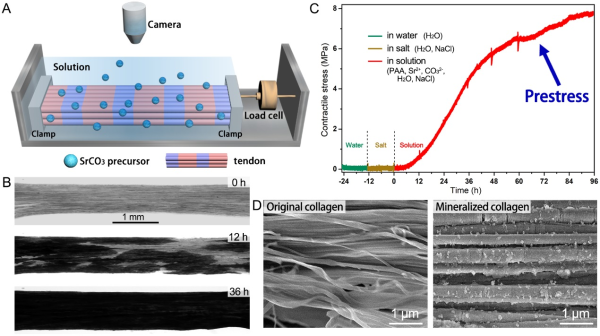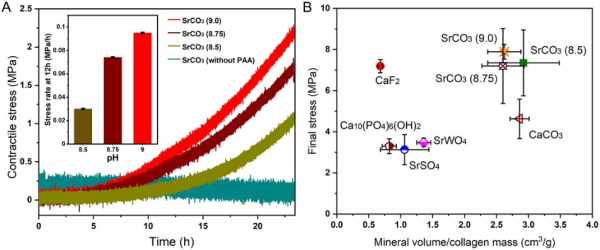
Recently, associate researcher Hang Ping from academician Zhengyi Fu’s group has made innovative progress in the research of bioprocessing-inspired fabrication. The paper entitled “Mineralization Generates Megapascal Contractile Stresses in Collagen Fibrils” was published in the international top academic journal, Science, with WUT’s State Key Laboratory of Advanced Technology for Materials Synthesis and Processing being the first corresponding affiliation, the Max Planck Institute for Colloidal Interfaces in Germany being the cooperation unit; Hang Ping being the first author, Academician Zhengyi Fu, Dr. Wolfgang Wagermaier, and Professor Peter Fratzl being the co-corresponding authors.
After billions of years of evolution and natural selection, natural biomaterials, such as shells, teeth and bones, can be structured at ambient temperature, resulting in unique microstructures and excellent properties. Academician Fu’s team suggests that it is worthwhile to learn from natural bioprocess to develop fabrication techniques for materials. Therefore, they propose a new research direction, namely bioprocessing-inspired fabrication. It aims at developing and designing novel fabrication technologies for materials with new structures and functions by drawing inspiration from the structure-forming process of biosystems or the relationship between the natural bioprocess and biological structures (Progress in Materials Science, 2019, 105, 100571).

Figure 1. Megapascal contractile stresses generated in collagen fibrils
Bone formation is a typical bioprocess, during which collagen fibrils mineralize with carbonated hydroxyapatite to form the basic structural unit in bone, leading to a special structure with excellent mechanical and functional properties. Inspired by the process of bone formation, Hang Ping, the associate research fellow, designed an experiment system of confined synthesis within collagen fibrils combined with in-operando characterization . Based on tendon tissues with the continuous orientation of collagen fibrils, the synthesis of SrCO3 within collagen fibrils is realized. This experiment first demonstrates the generation of megapascal contractile stress in synthesis product, and realizes the preparation of prestressing composite microtubules (fig.1). Using in-operando Raman analysis, small-angle x-ray scattering (SAXS) and wide-angle x-ray scattering (WAXS), they reveal the kinetics of SrCO3 synthesis within collagen fibrils and the formation mechanism of prestress (fig.2). By changing the chemical composition and other conditions of the mineralizing solution, the magnitude and formation rate of prestressing can be controlled (fig.3). The research also demonstrates that the synthesis of different inorganic materials inside collagen will also generate megapascal contractile stresses.

Figure 2. The formation mechanism of prestress
Hang Ping has carried out systematic research on the synthesis within collagen fibrils in the preliminary stage. Based on the functional properties of mineralization-induced protein in bone, he designed a multifunctional recombinant protein that could bind both collagen and apatite. It can regulate the growth of hydroxyapatite in the gap zones of collagen fibrils and make the synthetic hydroxyapatite arrange periodically along collagen fibrils (J. mater. Chem. B, 2015, 3, 4496; Chem. Sci., 2016, 7, 6330). The periodically ordered synthesis and crystallization of calcium fluoride nanocrystals in collagen fibrils came to fruition for the first time, revealing the process of structural formation in which the precursor first infiltrates the collagen fibrils from the gap zones and then diffuses into the overlap zones, instead of the conventional opinion that the precursor infiltrates collagen and directly diffuses along the long axis of fibril (J. Mater. Chem. B, 2021, 9, 6668). The confined-space synthesis of strontium carbonate piezoelectric functional materials within collagen fibrils was also realized for the first time (Adv. Funct. Mater., 2021, 31, 2105806).

Figure 3. Controllable generation and generality of prestress
These research works provide direct evidence for revealing the origin of prestress in biological minerals. Moreover, they have biological referential values for revealing the process of bone formation and are of great significance for the synthesis and fabrication of multifunctional hybrid materials.
Written by: Linglin Huang
Rewritten by: Huihui Li, Wenjun You, Zhongyuan Sun
Reviewed by: Xiaohan Luo, Hang Ping
Edited by: Tiantian Li
Source: State Key Laboratory of Advanced Technology for Materials Synthesis and Processing
|
|